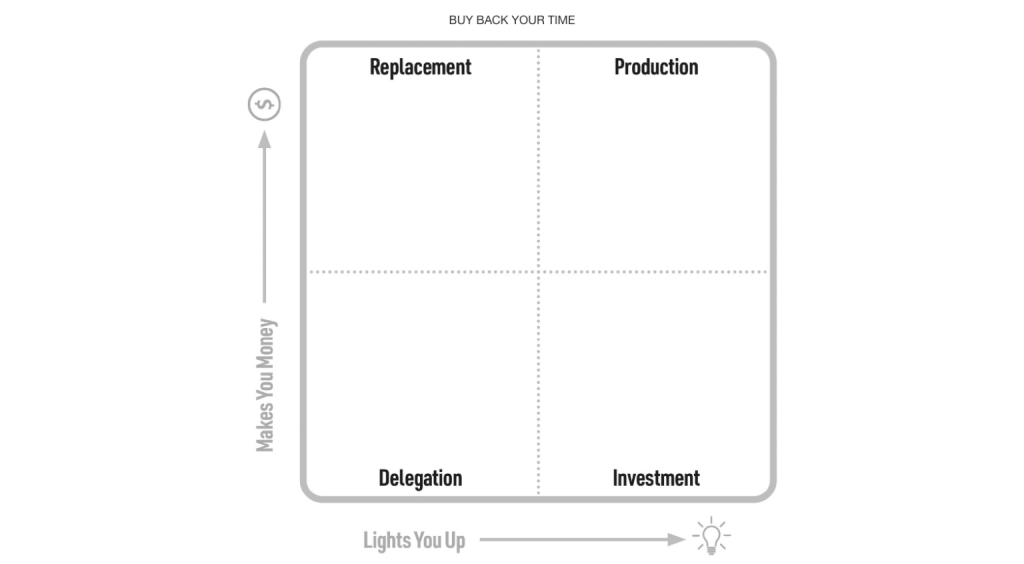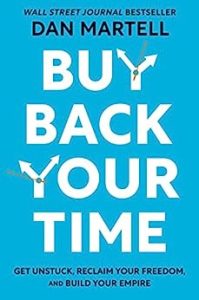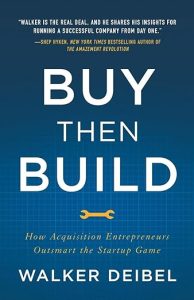I am a huge fan of Dan Martell – therefore, I am biased towards giving a great review of his book “Buy Back Your Time”.
This book is a GREAT read for anyone who is an entrepreneur or works closely with one. As someone who doesn’t self-identify as a entrepreneur, a lot of the examples and pain points Martell’s book highlights are true from my experience.
The entire premise of this book is how to use proven frameworks and mental models to shift your thinking on how you delegate tasks and work on high impact work. The ultimate goal is to have more time to make a bigger impact in your life and achieve the vision you set for yourself.
I’ve read dozens of books on this topic but this is the first I have found with practical frameworks that you can implement immediately and see results.
If you feel stressed, overwhelmed, overworked, or ungrateful for your business – I highly recommend you give this book a try.
Below I will highlight some of my biggest insights and favorite frameworks.
The Buy Back Principal: Don’t hire to grow your business. Hire to buy back your time.
Insights about growing your business
- You can’t personally outwork yourself to a better business. The problem is you only have twenty-four hours in a day.
- If you keep grinding you’ll eventually hit the “pain line” (when you want to quit or find a better way).
- The pain line should act as a feedback loop to embrace a new mindset.
- A buyback loop occurs as you continually audit your time to determine the low-value task that are sucking your energy. Then you transfer those tasks, optimally, to someone who’s better at them and enjoys them. Lastly, you fill your time with higher-value tasks that light you up and make you more money, rinse and repeat.
The DRIP Matrix

The DRIP matrix is used throughout the entirety of the book. At first I thought this was a rebrand of the Eisenhower matrix. However, it’s a little different but follows the same logic as most matrix top right = good, bottom left = bad.
Delegation = Find your buy back rate (annual revenue / 2000)/4* = $ hourly rate. Any task that you could hire out for less than your buy back rate is worth delegating to someone else. Example, checking your email.
*The 2000 numbers comes from average hours worked in a year and the 4 comes from trying to get a 4x ROI on your time.
Replacement = these are tasks that are harder to let go of. These might be something you are great at and requires training and more complicated process. Example, the sales process.
Production = this is an entrepreneurs unique genius or highest energy work. This is where you can create massive value and momentum in your business. You want to spend as much time as possible here. In order to get here you must be delegating and replacing yourself.
Investment = this is where business owners are allowed to have fun. You can invest in people, process, innovative ideas or events. Really it’s anything that gives you energy and lets you have fun so you can scale and grow to the next level of business.
Once you move tasks through this matrix – you should come back and audit the buy back loop. It’s an exercise that is repeated as you grow.
The Only 3 Trades That Matter
- Level 1 trader: employee
- Trades time for money.
- Focused on income.
- Level 2 trader: entrepreneur –
- Trades their money for time.
- Focused on leverage.
- Level 3 trader: empire-builder
- Trades their money for more money.
- Focused on freedom.
The Replacement Ladder
| Hire | Feeling | Ownership |
|---|---|---|
| Leadership | Flow | Strategy & outcomes |
| Sales | Freedom | Calls & follow-ups |
| Marketing | Friction | Campaigns & traffic |
| Delivery | Stalled | Onboarding & support |
| Admin | Stuck | Inbox & calendar |
Hiring according to the replacement ladder will help you avoid getting stuck in the replacement quadrant as it gives you a systematic way to transfer tasks. At each rung, the entrepreneur identifies their current feeling, recruits or promotes a key hire, then transfers the ownership of those responsibilities to that key hire. Then the entrepreneur moves to the next rung.
The Only 4 Time Hacks You Need
- Hack #1 – $50 Magic Pill
- Pick a $$$ amount that your team is able to spend without you have to approve it. This will speed up decision making and not make you the bottle neck. The balance is that they must be accountable to explain WHY they spent that money in finance review calls.
- Hack #2 – Sync Meetings with Repeat Agendas
- Have the same meeting with the same outcome on a set schedule so it can create velocity in your life/day/business. An example would be working with your EA and having the following agenda items (Off-load todos, calendar review, past meeting action items, current action items, feedback on projects, emails, questions that need answered).
- Hack #3 – A Definition Of Done
- Have a clear definition of done so you are aligned and someone isn’t expecting one result while you are expecting another. “This project is done when a customer no longer has to be notified if they miss an appointment.”
- Hack #4 – The 1:3:1 Rule
- Encourage your team to come with solutions to their problems. This will speed up decision making and empower employees. The 1:3:1 rule is
- 1 clearly defined problem
- 3 possible outcomes or options for the problem
- 1 recommendation you are making to the decision maker
How To Invite & Get Feedback
C – Create a warm environment. Invite them to share a piece of positive feedback first. It’s tough for them to offer critical feedback. However, they’ll probably think it’s easy to say something nice. So after they give you positive feedback, you can ask them to think—but don’t say out loud—that one bit of cringe-worthy feedback they could offer. All you’re doing here is creating a warm environment.
L – Lead them to offering critical feedback. Now that they’re thinking about that negative feedback, ask if they don’t mind sharing it. You can tell them that you already know you’re not perfect, but hearing some criticism might help you improve. Tell them your goal is to become a better leader.
E – Emphasize. Take it in. You don’t have to accept it, just listen. Make sure to repeat the feedback back to them, in your own words, so they know you really got it. Making them feel heard and understood is 80 percent of the value of this framework. After repeating it back, ask them if you got it right.
A – Ask if there’s more. People often lead with something small. Give them one more chance to share the real deal.
R – Reject or accept the feedback. Here, you can either accept or reject what they have to say. If you accept it, make a commitment for how you’ll change your behavior going forward. If you don’t accept it, thank them for the feedback.”
Saving A Players and Hundreds Of Thousands Of Dollars
- When someone quits, replacements can take months to find and train
- When an experienced employee leaves, years of company specific knowledge and expertise leaves with them
- When staff go to a new company, they’re transferring years of company knowledge, industry experience, client relationships and training into their new role.
Have A 10x Vision
This is the fuel to keep going when things get really hard. You need a huge inspirational picture of what you are working toward. Entrepreneurs are uniquely situated to positively affect and change the world. Big ideas inspire innovation, ecite others, help you overcome distractions, and make many business decision easier.
“When you can describe your future with the same level of detail as your present, you’ll have a compelling vision.”
Big Idea
The key idea is to constantly evaluate which tasks can be outsourced or delegated to free up time for strategic work that aligns with your goals and strengths. Martell provides practical steps for identifying these tasks, hiring effectively, and creating systems for delegation. He emphasizes time management, building scalable systems, and achieving more freedom and control over both personal and professional life.
The book offers advice on mindset shifts, how to assess the true value of your time, and how to create a business that supports your lifestyle without overwhelming you. It’s about building a sustainable business model where you can “buy back” your time while driving success.
Join The Newsletter
Get occasional emails from me when I publish new projects and articles.



